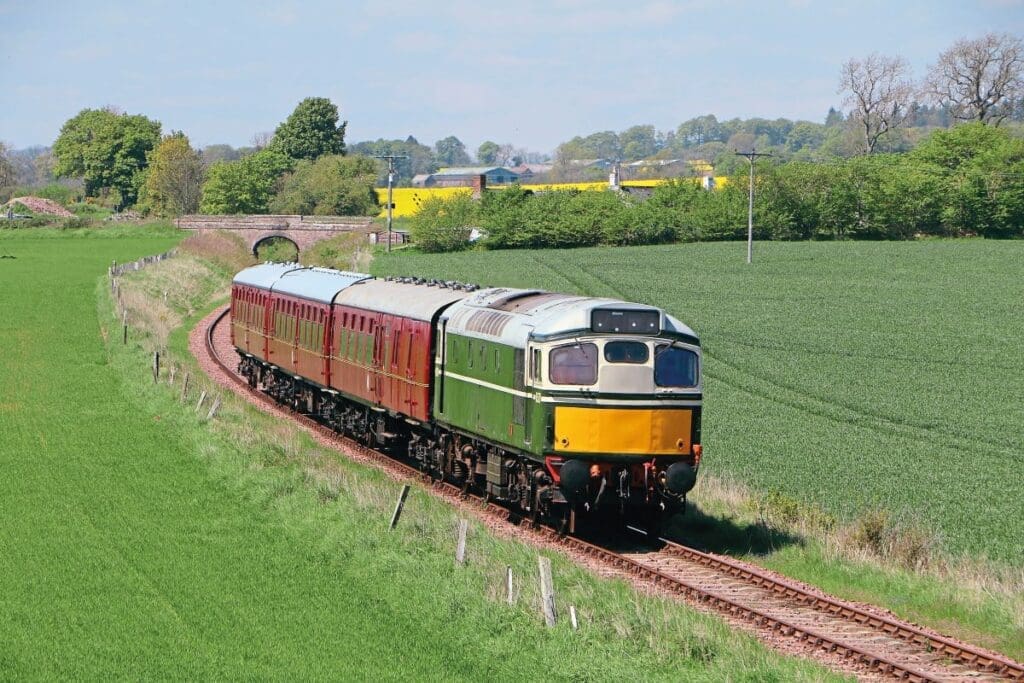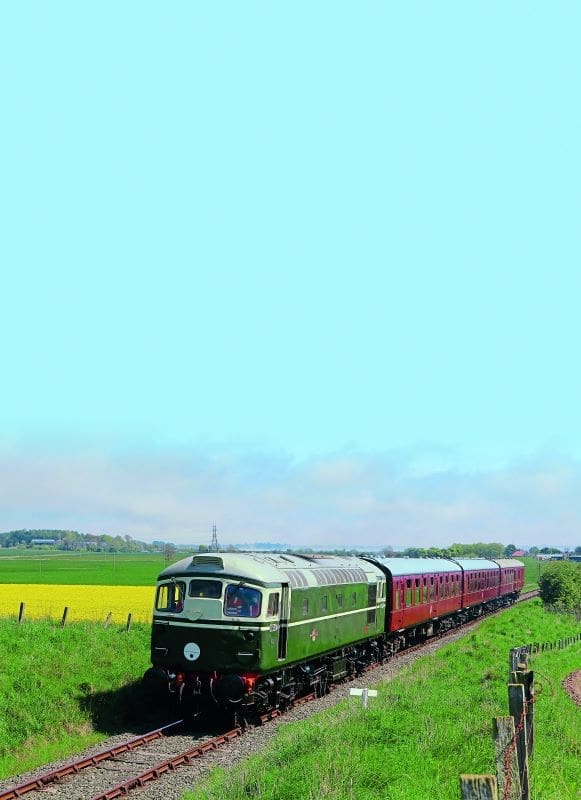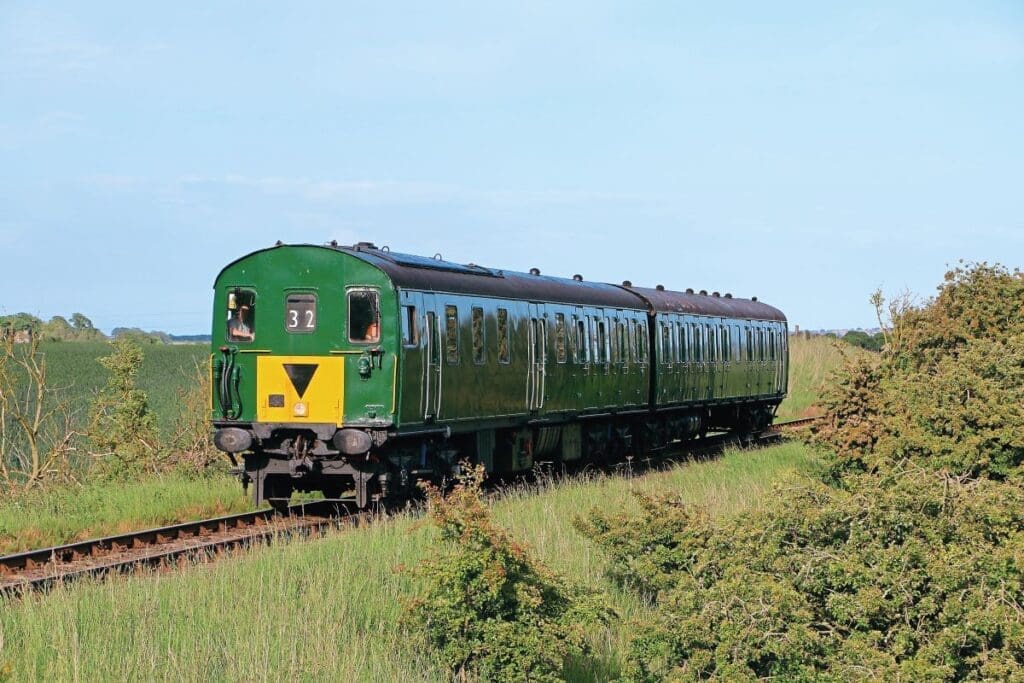The Caledonian Railway Diesel Group goes about its business with little fuss, but is responsible for an impressive collection of diesel locomotives, with the railway investing heavily in facilities to support ongoing restoration and maintenance. Andy Coward headed north to find out more.

Heritage modern traction enthusiasts in Scotland are fortunate, with several heritage railways located in the country boasting varied ex-British Rail diesel fleets for our enjoyment. Where could be better to go and get your fix of small Sulzers than Scotland, where the Class 26s and 27s reigned supreme for so long?
The Caledonian Railway has a truly enviable fleet of Sulzer Type 2 diesel locomotives in its collection, but despite having the no fewer than seven Sulzer Type 2s, there is still plenty of room for English Electric locomotives at this friendly heritage line.
The Caledonian Railway runs for four miles from the small town of Brechin to Bridge of Dun, running through scenic Scottish countryside. While it is arguably easy to understand why this mainly rural route was closed during the post-Beeching rationalisation of the railway network, it is an idyllic setting for a heritage line and when I visited in late March – sadly, before the main operating season had started – I was impressed with the railway, its facilities, and its friendly and enthusiastic volunteers.
I met Caledonian Railway diesel director Ken Joy and Caledonian Railway Diesel Group volunteer Raghnall Simmons to find out more about the railway’s growing fleet of diesel locomotives and plans for the future.

Protecting the fleet
For a relatively small railway, the diesel fleet is certainly impressive – with four Class 20s, three Class 26s, two Class 25s, a pair of Class 27s, a Class 14 and a Class 37 making up the ex-British Rail main line fleet, supported by a Class 08 shunter, a pair of Class 11s and two Class 205 Thumpers diesel-electric multiple units.
While nowhere near all these locomotives can be considered as operational, it shows the ambition of the Caledonian Railway to preserve our diesel heritage with a collection of locomotives that many larger railways would be envious of. This might be a small railway, but it has big ambition and big plans.
While this is undoubtedly a large collection of locomotives to maintain and restore, the particularly impressive aspect is that the railway has recently built a large three-road diesel shed to house virtually all of them safely and under cover, protecting them from the sometimes harsh Scottish climate. It represents a significant financial investment in maintenance facilities for the fleet, but also recognises the need for proper covered accommodation for this historic collection.
The new diesel shed at Bridge of Dun is the equivalent length of six Mk.1 coaches; once complete, it will become the main workshops and restoration base for the CRDG diesel fleet and all of the diesel locomotives based on the railway. For quite a small railway, this shed will help safeguard the fleet for future generations. When I visited, the new building wasn’t quite complete, but it is usable to a certain degree. The track has been laid within the main building and work on concreting the floor has begun – starting at the back of the shed and working forward, allowing the CRDG’s extensive collection of spares to be stored in a newly created and well-organised stores area. Lighting, machinery and tools have also been installed and commissioned to allow a new workshop area to be created and brought into use. A large area of the shed still needs to have its concrete floor installed and it is very much a case of ‘work in progress’, but you can see that the finishing line is in sight.
Walking through this facility, it is easy to appreciate its scale and what at a difference it will make to the volunteers who help maintain and restore the fleet. The railway had already previously built a reasonably big three-road shed slightly to the north of the new building, but this was more suited to storing locomotives rather than for ongoing restoration work due to its somewhat cramped internal layout.
Ken explained: “The new shed gives us a single facility to accommodate the diesel fleet, which will assist us greatly. The existing shed has been useful as a storage facility and has served us well, but the shed is in a different league.”
When I visited, the building was being mainly used to store the railway’s coaching stock during the winter closed season, along with a few diesel locomotives. When the concrete floor is finished, the existing diesel shed will be emptied and the locomotives transferred the short distance to the new shed, and the older building will be used for coaching stock storage.

Not a secret society
Although the locomotives are mainly owned by private individuals, many are maintained and restored under the umbrella of the CRDG, which consists of a pool of about 20 volunteers, with working parties at the weekends regularly attracting 10 to 12 people from the team, all helping to keep the operational locomotives – currently recently-arrived 20166, Class 26 D5314, Class 27 D5370 and the three diesel shunting locomotives – maintained and regularly serviced. The current focus of attention for the CRDG is on the completion of the new diesel facility and finishing the ongoing restoration of 37097 Old Fettercairn.
This is quite a young team, with many under the age of 40. They pride themselves on being close-knit – and they very much welcome newcomers who want to join in, although they also understand that the location of the railway sometimes means that volunteers attending from further afield are harder to come by. Raghnall says that anyone interested in becoming a volunteer can guarantee a friendly and warm reception.
The CRDG is generally not a group that shouts about its achievements. Its members tend to prefer working quietly away under the radar on their collection. The group does have a Facebook page, which is regularly updated with information about running days and special events, but in the main, the hard work done by volunteers goes on in the background.
Raghnall explained: “Giving updates usually results in many questions asking about when they will be ready and what colour they will be painted in. We are not deliberately secretive, but we try to be realistic. With major restoration projects, it is very difficult to say exactly when a locomotive will be ready for service until it has been completed and tested. That’s the point at which we can shout about it and tell people when it will be in use. Take 37097, for example. We have been working on this for a few years now and its rebuild is now reaching an advanced stage. If you look inside, you will see that the work has been done to a very high standard, but realistically it is probably still about two years away from being ready to haul a train again.
“Until it is up and running and we are relatively confident that it is ready to haul trains again, there is little benefit in making statements about when it will be back in use.”
High standards
Raghnall gave me a tour of the Class 37, and standing in the engine room, it is clear to see that the work being done is to a very high standard. The engine room and English Electric 12CSVT power unit are immaculate – you could be mistaken for thinking you were looking at a museum piece, but this shows the level of detail and attention carried out by the CRDG volunteers. He is very proud of the work and says that while the team is looking forward to the day when its restoration is complete, members are making sure it is being done properly and is not being rushed back into service.
From what I can see, it will definitely be worth the wait.
Meet the fleet
But what of the other diesel locomotives at Bridge of Dun? Hidden away behind closed doors are 25072 and 25083, which have never worked in preservation. The two Class 25s show the comparison between the two cab designs, with 25072 featuring the earlier style with a small central cab window, while 25083 has the later designed larger centre cab windscreen.
25083 had a large amount of work carried out internally many years ago, but work on its restoration was stopped some time ago due to 37097 needing urgent repair work (which then turned into a major overhaul of the Class 37) and the Class 25 still requires much work to be completed before it can be reactivated.
However, Ken says that the CRDG would like to get 25083 back into operational condition, and it is hoped that restoration to working order will begin in earnest once 37097 has returned to traffic in a couple of years’ time.
In the case of 25072, this locomotive is still largely in the condition it was in when withdrawn by BR and sits patiently awaiting its turn for attention at some point in the future.
The investment the railway has made in covered attention has certainly paid dividends in terms of preventing further deterioration to the collection, and locomotives such as the Class 25s have benefitted from being indoors and protected from the weather.
The CRDG has three Class 26s, with D5314 the current mainstay of the operational diesel fleet. The immaculately restored locomotive has proved to be extremely reliable, with only routine servicing and maintenance required.
I was fortunate in being able to join Ken on a cab ride along the railway, the Class 26 delivering an engineering train to Brechin on the day of my visit.
The locomotive did not miss a beat and is clearly very well looked after by the CRDG volunteers. It is also clear that while they have a large fleet of locomotives in their care, they take great pride in ensuring the operational fleet is kept in the best possible condition.
The railway is also home to former Lakeside & Haverthwaite Railway based D5301, which was previously owned by MC Metals owner Jim McWilliam. The second-built Class 26 operated on the Caledonian Railway for several years but is now out of traffic awaiting a body lift to carry out bogie repairs.
Raghnall says that following the laying of the concrete floor, lifting jacks will be installed, which should allow the necessary repairs to be progressed on the Class 26, but it remains in store until these are ready.
The same problem is also affecting BR blue-liveried 26035, which is positioned alongside its classmate in the shed also awaiting a body lift, so that bogie repairs can be completed. The two Class 26s have received preventative maintenance to keep them in as good a condition as possible while they await the necessary repairs to allow them to return to traffic.
BR green Class 27 D5370 is a regular performer on the railway and is another generally reliable member of the fleet, although Ken explained that the locomotive is getting close to needing some bodywork repairs; at the time of my visit at the end of March, it was undergoing winter maintenance work ahead of the start of the railway’s main operating season in June.
The Caledonian Railway is also home to four Class 20s, although only one of these – recently arrived 20166 – is operational. Again, the Class 20s are privately owned and the locomotives are all stored inside the new diesel shed at Bridge of Dun.
Raghnall said that 20166 has now joined the operational fleet, but the other three – 20016/081/088 – require extensive rebuilds, having been stored out of use for many years. Whether all return to service remains to be seen, but it is hoped that at least one or two will be revived when there is the time and resources available to give them the attention they need.
While the diesel-hydraulics were once prominent in the Western Region, a Class 14 has now made the Caledonian Railway its home following the movement of D9553 to the railway last year. The locomotive is privately owned and the majority of the restoration is being carried out by its owner, with some assistance being provided by CRDG volunteers. Work is well underway on its revival at Bridge of Dun and it will join the operational roster when complete.

Supporting cast
The main diesel fleet is supported by three former BR shunters – in the form of Class 08 3059 and Class 11s 12052 and 12093. All three are operational, and 12052 worked its first train in preservation last year, with Raghnall saying that it is possible that this was the first time it had ever hauled a passenger service.
Another relatively recent development is the relocation of two Class 205 three-car Thumper DEMUs – 205028 and 205032 – from the erstwhile Dartmoor Railway.
Raghnall explained that there are plans to return 205032 to service on the railway as soon as it is able. The unit is essentially in operational condition but requires a wheelset change and some other minor repairs before it can enter traffic. The wheelset change will be quite a challenge for the CRDG volunteers, but it will be done so the unit can be used once more.
The other unit, 205028, is not operational and there have been talks of converting it for operation using alternative fuels as a trial at some point in the future, but this will only be progressed once classmate 205032 is operational.
The CRDG is a well-organised and motivated team of volunteers, and the Caledonian Railway has made some wise investments in providing good facilities to support the locomotive fleet that should certainly help to pay dividends in the years to come.
To my shame, I had never visited the Caledonian Railway until now, but having been there, travelled along the line, and met some of the volunteers involved in running it, I will definitely be back in the future. It is honestly one of the most scenic and friendliest heritage lines I’ve visited – if you haven’t made the effort to head north, do yourself a favour and visit soon. You won’t be disappointed.
Re-established in 2018 after a break for a few years, Sulzer Symphony is the name given to the Caledonian Railway’s annual diesel gala, which takes place this year on August 4-6.
The event should see 3059, 20166, D5314 and D5370 all in service throughout the three days of the event, operating an intensive timetable. Trains will also be hauled by a combination of single and double-headed locomotives.
More details and updates about the event can be read on the CRDG’s Facebook page, which can be found at www.facebook.com/CRDGBrechin


